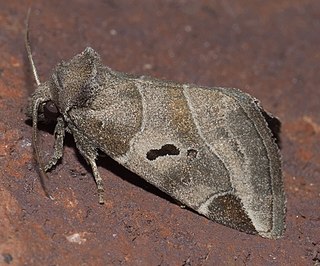Related Research Articles

The Noctuidae, commonly known as owlet moths, cutworms or armyworms, are a family of moths. They are considered the most controversial family in the superfamily Noctuoidea because many of the clades are constantly changing, along with the other families of the Noctuoidea. It was considered the largest family in Lepidoptera for a long time, but after regrouping Lymantriinae, Catocalinae and Calpinae within the family Erebidae, the latter holds this title now. Currently, Noctuidae is the second largest family in Noctuoidea, with about 1,089 genera and 11,772 species. This classification is still contingent, as more changes continue to appear between Noctuidae and Erebidae.

Noctuoidea is the superfamily of noctuid or "owlet" moths, and has more than 70,000 described species, the largest number of any Lepidopteran superfamily. Its classification has not yet reached a satisfactory or stable state. Since the end of the 20th century, increasing availability of molecular phylogenetic data for this hugely successful radiation has led to several competing proposals for a taxonomic arrangement that correctly represents the relationships between the major lineages.
House & Garden is a shelter magazine published by Condé Nast Publications that focusses on interior design, entertaining, and gardening that began in the USA in 1901.

Léonie Fuller Adams was an American poet. She was appointed the seventh Poet Laureate Consultant in Poetry to the Library of Congress in 1948.

The Calpinae are a subfamily of moths in the family Erebidae described by Jean Baptiste Boisduval in 1840. This subfamily includes many species of moths that have a pointed and barbed proboscis adapted to piercing the skins of fruit to feed on juice, and in the case of the several Calyptra species of vampire moths, to piercing the skins of mammals to feed on blood. The subfamily contains some large moths with wingspans longer than 5 cm (2 in).

Acontiinae is a subfamily of bird dropping moths in the family Noctuidae. There are more than 50 genera and 430 described species in Acontiinae, found worldwide in temperate and tropical climates.

Drasteria is a genus of moths in the family Erebidae.

Thiacidas is a genus of moths of the family Noctuidae described by Francis Walker in 1855. Species are distributed throughout India, Sri Lanka and Myanmar.

Stiriinae is a subfamily of owlet moths in the family Noctuidae. There are more than 20 genera and 130 described species in Stiriinae.

The Erebinae are a subfamily of moths in the family Erebidae erected by William Elford Leach in 1815. Erebine moths are found on all continents except Antarctica, but reach their greatest diversity in the tropics. While the exact number of species belonging to the Erebinae is not known, the subfamily is estimated to include around 10,000 species. Some well-known Erebinae include underwing moths (Catocala) and witch moths (Thermesiini). Many of the species in the subfamily have medium to large wingspans, up to nearly 30 cm in the white witch moth, which has the widest wingspan of all Lepidoptera. Erebine caterpillars feed on a broad range of plants; many species feed on grasses and legumes, and a few are pests of castor bean, sugarcane, rice, as well as pistachios and blackberries.
Eutelia catephioides is a moth of the family Noctuidae. It is found in South Africa, Ethiopia and Saudi Arabia.

Thiacidas alboporphyrea is a moth of the family Noctuidae. It is found in Madagascar and the adults have a wingspan of 50 mm.

Léonie Sazias was a Dutch politician. A member of the 50PLUS party, she served in the House of Representatives from 2017 to 2021.
References
- Hacker, H. H. & Zilli, A. 2007. Revisional notes on the genus Thiacides Walker, 1855, with descriptions of Thiacidinae subfam. nov. and eleven species (Lepidoptera: Noctuidae). - Esperiana Memoir 3:179–246, pls. 21–30.